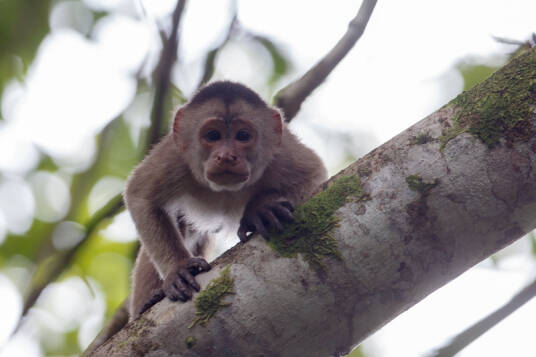Cebus cuscinus
IUCN
LCBasic Information
Scientific classification
- name:Cebus cuscinus
- Scientific Name:Cebus cuscinus, Shock-headed Capuchin, Machin de Cara Blanca
- Outline:Primates
- Family:C.monkeys
Vital signs
- length:30-45cm
- Weight:1.4-3.26kg
- lifetime:About 20 years
Feature
There is a round black spot on the top of the head
Distribution and Habitat
The range is from Peru (from the south bank of the upper Purus River in the southeast) westward into the Urubamba Valley (Río Urubamba) in Cuzco Province, and the southern and eastern parts of the Tambopata Basin. The range extends further into northwestern Bolivia and possibly into the Brazilian state of Acre.
Inhabits lowland land and seasonally flooded forests in the upper Amazon, and montane forests up to 1,800 m above sea level on the western slopes of the Andes.
Appearance
Adult male helmeted capuchin weighs 1.7-3.26 kg (average 2.49 kg); adult female: 1.4-2.23 kg (average 1.81 kg). The head is small compared to the body, the trunk is slender, and the limbs are slender. The back is light brown, and the ventral side is lighter, usually yellow and red. The dorsal hair is long and soft, which contrasts with the short and rough fur on the abdomen. There is a round black patch on the top of the head. Females may have a tuft of hair in front of this patch. The face is covered with sparse light hair, and peach-colored fleshy cheeks are visible. There is a thin white border around the face. A stripe that is slightly darker than the body color runs parallel to the spine. The limbs are yellow and reddish brown.
Details
Cebus cuscinus (Scientific name: Cebus cuscinus) English Shock-headed Capuchin, Spanish Machin de Cara Blanca, no subspecies. The helmeted capuchin is a slender capuchin monkey distributed in Bolivia, Brazil and Peru. Hershkovitz listed 13 subspecies of the white-fronted capuchin (C.albifrons Humboldt, 1812) in 1949, including "C.a.cuscinus Gray 1901" from upper Peru. The helmeted capuchin is considered a subspecies of the white-fronted capuchin. Genetic analysis conducted by Jean Boubli in 2012 showed that the species should be an independent primate species.

Helmeted capuchins are extractive, manipulative foragers. Like other capuchins, the species prefers to live in the middle to upper levels of the canopy, but occasionally forages on the ground. The average group size is 19.8 individuals, with males outnumbering females and an adult sex ratio of 1.08. Males disperse from their mother group upon reaching adulthood. Both sexes follow a linear hierarchy, with the highest-ranking males dominating the highest-ranking females. Subordinate males are often marginalized. There is a peak fertility period, with births spaced 18 months apart.
Capuchins are frugivores-insectivores, which include a wide variety of fruits, seeds, and arthropods, frogs, nestlings, and even small mammals, supplemented by stems, flowers, and leaves.
Capuchins, unlike other species in the genus, have a peak fertility period, with most births likely coinciding with the dry season. Females in estrus will actively respond to males seeking mating. Males can detect females in estrus through chemical signals in their urine. Females give birth 18 months apart, with one litter per calf, and a gestation period of about 150-160 days. Care of the young is not limited to the female, other group members will help young in distress, and dominant males often take care of the young. When the young are less than 2 months old, other females will also care for, nurse and feed them. Males separate from their natal group when they reach sexual maturity, while females remain in their natal group.
Hunting is the main threat to the species throughout its range, along with forest loss and fragmentation. Data from Global Forest Watch for the species' range shows that the rate of forest loss is accelerating. If forest habitat continues to decline at the current rate, more than 30% of the Brazilian state of Acre, about 15% of the Peruvian provinces of Cusco and Madre de Dios, and about 10% of the Bolivian provinces of La Paz and Pando will be lost over the course of the next 48 years (three generations). Species of the genus Capuchin are among the most common primates in the illegal pet trade (accounting for 18% of all primates found between 2000 and 2014) and are tourist attractions in illegal zoos and circuses, accounting for 33% of all primates recorded between 2000 and 2014 (Shanee 2015). This combination of threats, and the fact that the Capuchin is known to occur in only a few protected areas, leads experts to believe that the species qualifies for Near Threatened status.
Listed in the IUCN Red List of Threatened Species 2015 ver3.1 - Near Threatened (NT).
Listed in Appendix I, Appendix II and Appendix III of the 2019 edition of the Convention on International Trade in Endangered Species of Wild Fauna and Flora (CITES).
Protect wild animals and eliminate game.
Maintaining ecological balance is everyone's responsibility!








